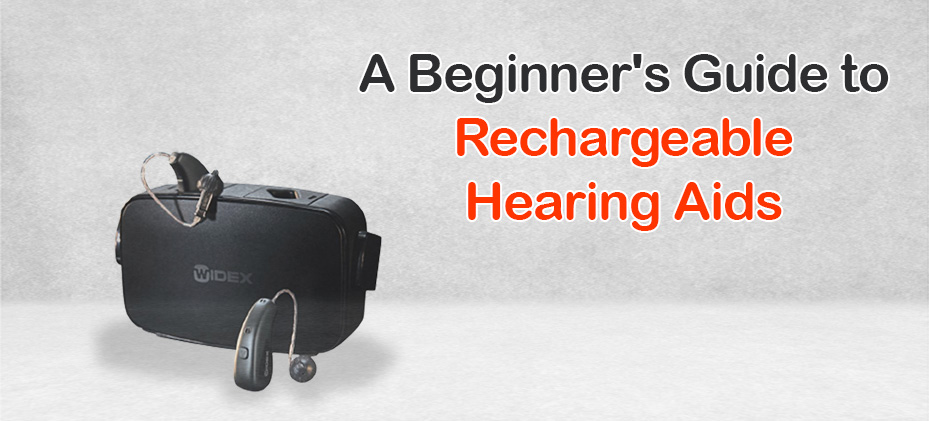 Call Us
Call Us
 Mail Us
Mail Us

As people age, their hearing often deteriorates, which can make it difficult to communicate with others or enjoy certain activities. Hearing aids are a popular solution for this problem, but traditional hearing aids require regular replacement of disposable batteries, which can be costly and environmentally unfriendly.
Rechargeable hearing aids offer a convenient and eco-friendly alternative. Let’s discuss everything you need to know about rechargeable hearing aids.
Rechargeable hearing aids are devices designed to help people with hearing loss hear better. Unlike traditional hearing aids that use disposable batteries, rechargeable hearing aids use a built-in battery that can be recharged using a charging station or a USB cable.
Rechargeable hearing aids work similarly to traditional hearing aids, with the exception that they don't require frequent battery replacements. Instead, they come with a rechargeable battery that can last for several years before needing to be replaced. The battery is charged using a charging station or a USB cable, and the process typically takes a few hours.
Rechargeable hearing aids work just like traditional hearing aids, but they come with a rechargeable battery. Instead of replacing disposable batteries, users can simply charge their hearing aids overnight using a charging station or cable. The battery life varies depending on the brand and model of the hearing aid, but most rechargeable hearing aids offer at least 24 hours of use on a single charge.
Rechargeable hearing aids have a number of advantages. First and foremost, they are more convenient than traditional hearing aids because you don’t have to worry about replacing batteries regularly. In Long-term, this can save you both time and money. Additionally, rechargeable hearing aids are more environmentally friendly because they reduce the number of disposable batteries that end up in landfills.
When choosing a rechargeable hearing aid, there are several factors to consider. First, you want to look for a reputable brand that offers a warranty and good customer service. You also want to consider the battery life and charging time of the hearing aid. Look for a model that offers at least 24 hours of use on a single charge and a charging time of four hours or less. Finally, consider the features and settings of the hearing aid. Some models offer Bluetooth connectivity, directional microphones, and noise-reduction features, which can improve your listening experience.
It's crucial to take proper care of your rechargeable hearing aids to make sure they last as long as possible. When not in use, keep them in a cool, dry location and regularly wipe them down with a soft, dry cloth.
Avoid exposing them to extreme temperatures or moisture, and don’t use harsh chemicals or solvents to clean them. Follow the manufacturer’s instructions for charging and storing your hearing aids.
Caring for your rechargeable hearing aids is essential to ensure their longevity and effectiveness. The following advice can help you keep them in good format:
Use a soft, dry cloth or a cleaning brush to regularly clean your hearing aids.
Language therapy: This involves working on understanding and using language.
Keep your hearing aids out of the heat, moisture, and bright sunshine.
Keep your hearing aids in a cold, dry environment.
To save battery life, remove your hearing aids when not in use.
There are several advantages to using rechargeable hearing aids. Firstly, they are more convenient as you don&'t have to worry about carrying spare batteries or constantly replacing them. Secondly, they are more environmentally friendly as you are not contributing to battery waste. Lastly, they can be more cost-effective in the long run as you won't need to buy replacement batteries.
There are two main types of rechargeable hearing aids: those with built-in
rechargeable batteries and those with rechargeable batteries that can be
removed and replaced. Both types have their advantages and disadvantages, and
it's important to consider your lifestyle and needs before choosing the right one for you.
Built-in rechargeable batteries are typically smaller and lighter, making the hearing aids more discreet and comfortable to wear. However, if the battery life deteriorates over time, the entire hearing aid will need to be replaced. On the other hand, hearing aids with removable batteries can be easily replaced, but the battery compartment may make the hearing aids slightly bulkier.
When choosing rechargeable hearing aids, there are several factors to consider, including:
1. Battery life: Make sure to choose a device with a battery life that meets your needs.
2. Charging options: Some rechargeable hearing aids come with a charging station, while others can be charged using a USB cable.
3. Compatibility: Make sure the hearing aids you choose are compatible with your phone or other devices.
4. Price: Rechargeable hearing aids can be more expensive than traditional hearing aids, so consider your budget before making a purchase.
Ambulkar Speech and Hearing Clinic rechargeable hearing aids are a convenient and eco-friendly alternative to traditional hearing aids. They offer many benefits, including cost savings, convenience, and environmental sustainability. When choosing a rechargeable hearing aid, consider factors such as battery life, charging time, and features. And remember to take good care of your hearing aids to ensure they last as long as possible.